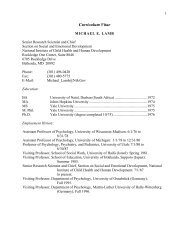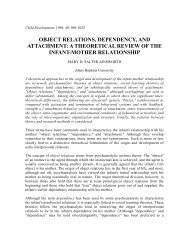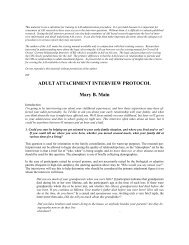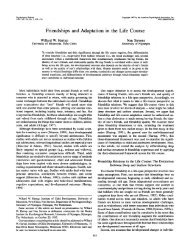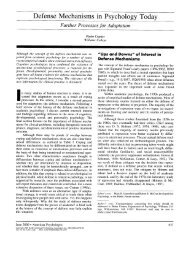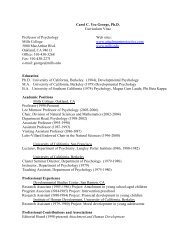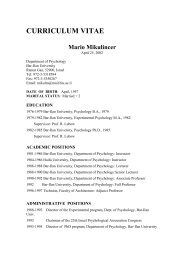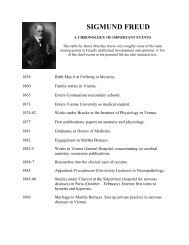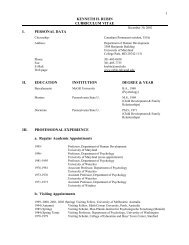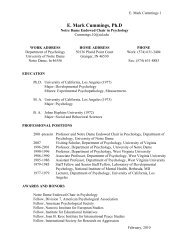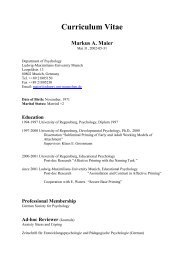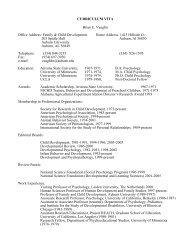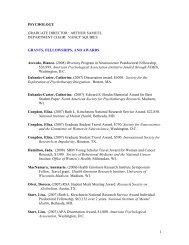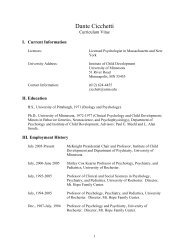the origins of attachment theory: john bowlby and mary ainsworth ...
the origins of attachment theory: john bowlby and mary ainsworth ...
the origins of attachment theory: john bowlby and mary ainsworth ...
You also want an ePaper? Increase the reach of your titles
YUMPU automatically turns print PDFs into web optimized ePapers that Google loves.
for parents is still not heeded today:<br />
Just as children are absolutely dependent on <strong>the</strong>ir parents for sustenance, so in all hut <strong>the</strong><br />
most primitive communities, are parents, especially <strong>the</strong>ir mo<strong>the</strong>rs, dependent on a greater<br />
society for economic provision. If a community values its children it must cherish <strong>the</strong>ir<br />
parents. (Bowlby, 1951, p. 84)<br />
True to <strong>the</strong> era in which <strong>the</strong> WHO report was written, Bowlby emphasized <strong>the</strong> female parent. In<br />
infancy, he comments, fa<strong>the</strong>rs have <strong>the</strong>ir uses, but normally play second fiddle to mo<strong>the</strong>r. Their<br />
prime role is to provide emotional support to <strong>the</strong>ir wives’ mo<strong>the</strong>ring.<br />
The proposition that, to thrive emotionally, children need a close <strong>and</strong> continuous caregiving rela-<br />
tionship called for a <strong>the</strong>oretical explanation. Bowlby was not satisfied with <strong>the</strong> <strong>the</strong>n current psy-<br />
choanalytic view that love <strong>of</strong> mo<strong>the</strong>r derives from sensuous oral gratification, nor did he agree<br />
with social learning <strong>the</strong>ory’s claim that dependency is based on secondary reinforcement (a con-<br />
cept that was itself derived from psychoanalytic ideas). Like Spitz (1946) <strong>and</strong> Erikson (1950),<br />
Bowlby had latched onto <strong>the</strong> concept <strong>of</strong> critical periods in embryological development <strong>and</strong> was<br />
casting about for similar phenomena at <strong>the</strong> behavioral level when, through a friend, he happened<br />
upon an English translation <strong>of</strong> Konrad Lorenz’s (1935) paper on imprinting.<br />
From <strong>the</strong>n on, Bowlby began to mine ethology for useful new concepts. Lorenz’s (1935)<br />
account <strong>of</strong> imprinting in geese <strong>and</strong> o<strong>the</strong>r precocial birds especially intrigued him, because it<br />
suggested that social bond formation need not be tied to feeding. In addition, he favored<br />
ethological methods <strong>of</strong> observing animals in <strong>the</strong>ir natural environment, because this approach was<br />
so compatible with <strong>the</strong> methods Robertson had already developed at <strong>the</strong> Tavistock research unit.<br />
One notable talent that stood Bowlby in great stead throughout his pr<strong>of</strong>essional life was his<br />
ability to draw to himself outst<strong>and</strong>ing individuals who were willing <strong>and</strong> able to help him acquire<br />
expertise in new fields <strong>of</strong> inquiry that he needed to master in <strong>the</strong> service <strong>of</strong> <strong>the</strong>ory building To<br />
learn more about ethology, Bowlby contacted Robert Hinde, under whose “generous <strong>and</strong> stern<br />
guidance” (see Bowlby, 1980b, p. 650) he mastered ethological principles to help him find new<br />
ways <strong>of</strong> thinking about infant mo<strong>the</strong>r <strong>attachment</strong>. Conversely, Hinde’s fascinating studies <strong>of</strong><br />
individual differences in separation <strong>and</strong> reunion behaviors <strong>of</strong> group-living rhesus mo<strong>the</strong>r infant<br />
dyads (Hinde & Spencer-Booth, 1967) were inspired by <strong>the</strong> contact with Bowlby <strong>and</strong> his<br />
co-workers (Hinde, 1991).



